The AMD A8-7650K APU Review, Also New Testing Methodology
by Ian Cutress on May 12, 2015 10:00 AM ESTGaming Benchmarks: Mid-Range
Alien: Isolation
If first person survival mixed with horror is your sort of thing, then Alien: Isolation, based off of the Alien franchise, should be an interesting title. Developed by The Creative Assembly and released in October 2014, Alien: Isolation has won numerous awards from Game Of The Year to several top 10s/25s and Best Horror titles, ratcheting up over a million sales by February 2015. Alien: Isolation uses a custom built engine which includes dynamic sound effects and should be fully multi-core enabled.
For low end graphics, we test at 720p with Ultra settings, whereas for mid and high range graphics we bump this up to 1080p, taking the average frame rate as our marker with a scripted version of the built-in benchmark.
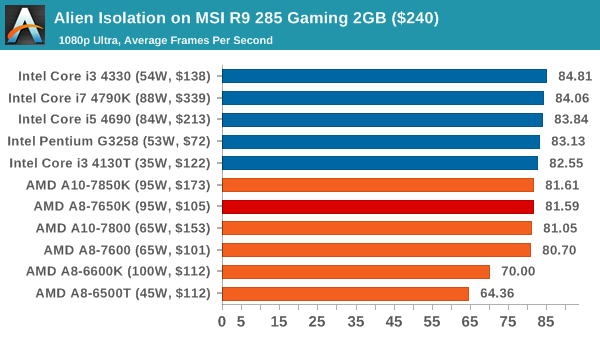
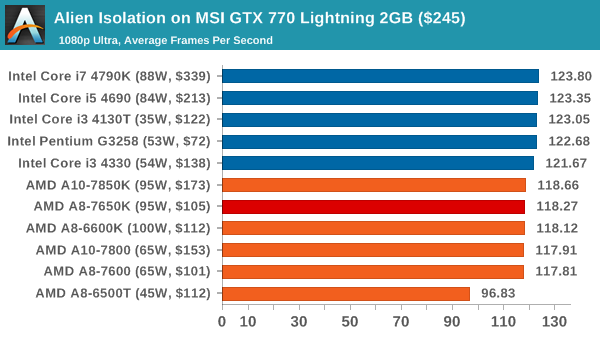
For mid range cards, Alien Isolation has a direct split for Intel and AMD, but the difference is a few FPS at best. It would seem that cores matter not here.
Total War: Attila
The Total War franchise moves on to Attila, another The Creative Assembly development, and is a stand-alone strategy title set in 395AD where the main story line lets the gamer take control of the leader of the Huns in order to conquer parts of the world. Graphically the game can render hundreds/thousands of units on screen at once, all with their individual actions and can put some of the big cards to task.
For low end graphics, we test at 720p with performance settings, recording the average frame rate. With mid and high range graphics, we test at 1080p with the quality setting. In both circumstances, unlimited video memory is enabled and the in-game scripted benchmark is used.
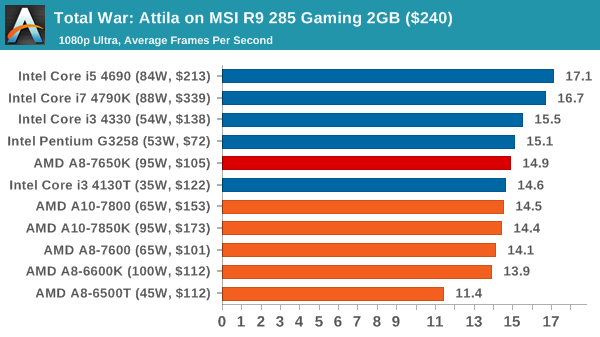
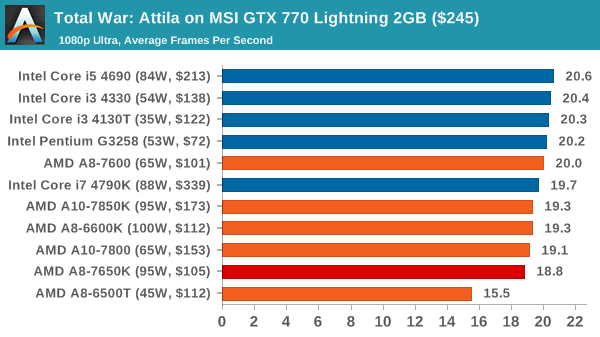
Neither combination here pulls Attila into a reasonable gaming rate, although there are bigger differences using the R9 285 GPU.
Grand Theft Auto V
The highly anticipated iteration of the Grand Theft Auto franchise finally hit the shelves on April 14th 2015, with both AMD and NVIDIA in tow to help optimize the title. GTA doesn’t provide graphical presets, but opens up the options to users and extends the boundaries by pushing even the hardest systems to the limit using Rockstar’s Advanced Game Engine. Whether the user is flying high in the mountains with long draw distances or dealing with assorted trash in the city, when cranked up to maximum it creates stunning visuals but hard work for both the CPU and the GPU.
For our test we have scripted a version of the in-game benchmark, relying only on the final part which combines a flight scene along with an in-city drive-by followed by a tanker explosion. For low end systems we test at 720p on the lowest settings, whereas mid and high end graphics play at 1080p with very high settings across the board. We record both the average frame rate and the percentage of frames under 60 FPS (16.6ms).
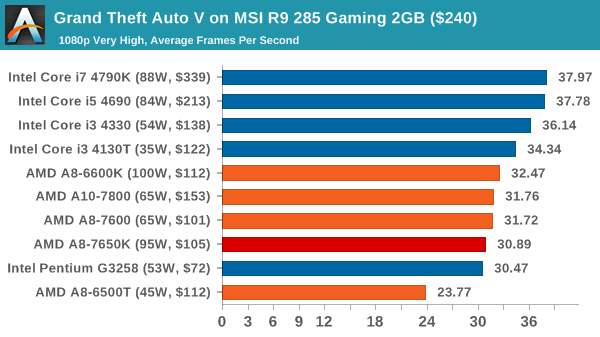
![Grand Theft Auto V on MSI R9 285 Gaming 2GB ($240) [Under 60 FPS]](https://images.anandtech.com/graphs/graph9217/74236.png)

![Grand Theft Auto V on MSI GTX 770 Lightning 2GB ($245) [Under 60 FPS]](https://images.anandtech.com/graphs/graph9217/74246.png)
On GTA, the G3258, the i3-4130T and the A8-7650K perform similarly, within a few frames of each other. Though in both circumstances the $200+ CPUs give the peak performance, up to 20% more than the $100 set.
GRID: Autosport
No graphics tests are complete without some input from Codemasters and the EGO engine, which means for this round of testing we point towards GRID: Autosport, the next iteration in the GRID and racing genre. As with our previous racing testing, each update to the engine aims to add in effects, reflections, detail and realism, with Codemasters making ‘authenticity’ a main focal point for this version.
GRID’s benchmark mode is very flexible, and as a result we created a test race using a shortened version of the Red Bull Ring with twelve cars doing two laps. The car is focus starts last and is quite fast, but usually finishes second or third. For low end graphics we test at 1080p medium settings, whereas mid and high end graphics get the full 1080p maximum. Both the average and minimum frame rates are recorded.
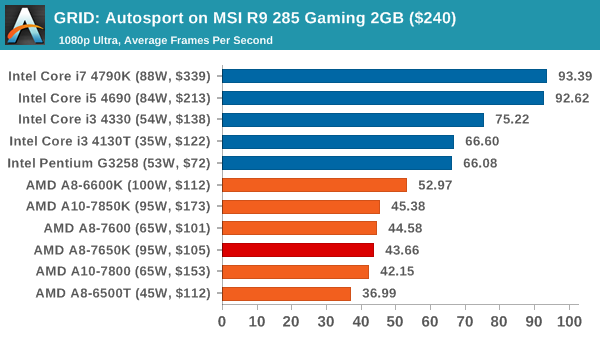
![GRID: Autosport on MSI R9 285 Gaming 2GB ($240) [Minimum FPS]](https://images.anandtech.com/graphs/graph9217/74238.png)

![GRID: Autosport on MSI GTX 770 Lightning 2GB ($245) [Minimum FPS]](https://images.anandtech.com/graphs/graph9217/74248.png)
GRID on an R9 285 seems to love Intel and loves more cores, as shown by the jump from the i3 to the i5. Whereas on a GTX 770, both teams perform similarly, well north of 60 FPS, although the difference lies more in the minimum frame rates.
Middle-Earth: Shadows of Mordor
The final title in our testing is another battle of system performance with the open world action-adventure title, Shadows of Mordor. Produced by Monolith using the LithTech Jupiter EX engine and numerous detail add-ons, SoM goes for detail and complexity to a large extent, despite having to be cut down from the original plans. The main story itself was written by the same writer as Red Dead Redemption, and it received Zero Punctuation’s Game of The Year in 2014.
For testing purposes, SoM gives a dynamic screen resolution setting, allowing us to render at high resolutions that are then scaled down to the monitor. As a result, we get several tests using the in-game benchmark. For low end graphics we examine at 720p with low settings, whereas mid and high end graphics get 1080p Ultra. The top graphics test is also redone at 3840x2160, also with Ultra settings, and we also test two cards at 4K where possible.
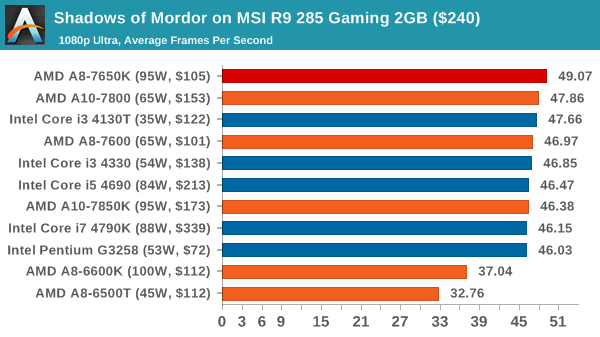
![Shadows of Mordor on MSI R9 285 Gaming 2GB ($240) [Minimum FPS]](https://images.anandtech.com/graphs/graph9217/74240.png)
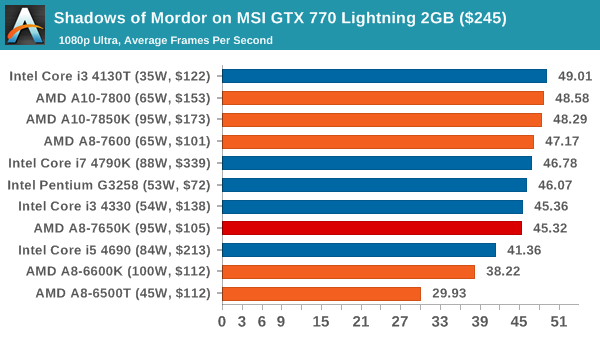
![Shadows of Mordor on MSI GTX 770 Lightning 2GB ($245) [Minimum FPS]](https://images.anandtech.com/graphs/graph9217/74250.png)
Interestingly the APUs so well at 1080p SoM, especially in average frame rates. Unfortunately this does not translate well in minimum frame rates.
Middle-Earth: Shadows of Mordor at 4K
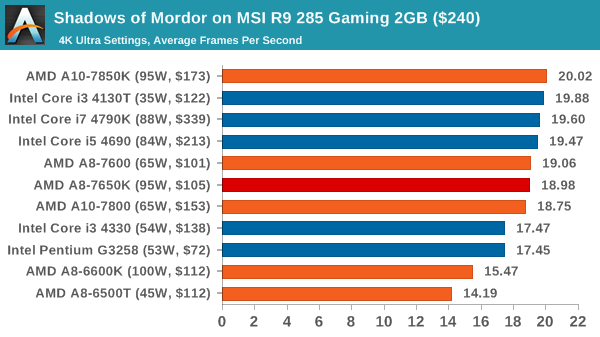
![Shadows of Mordor on MSI R9 285 Gaming 2GB ($240) [Minimum FPS]](https://images.anandtech.com/graphs/graph9217/74240.png)
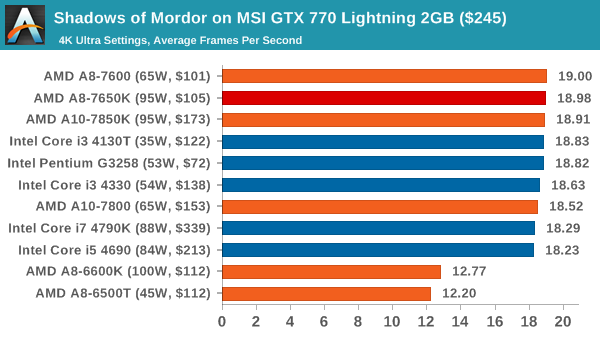
![Shadows of Mordor on MSI GTX 770 Lightning 2GB ($245) [Minimum FPS]](https://images.anandtech.com/graphs/graph9217/74252.png)
At 4K, the older 6000 series APUs seem to be a little behind. With the R9 285 there is also a staggered affect in average FPS performance, although a clear definition in minimum frame rates.















177 Comments
View All Comments
silverblue - Tuesday, May 12, 2015 - link
I heard a rumour that AMD were unable to meet demand and as such failed to secure a contract with Apple. Make of that what you will. As it was, Llano went from being under-produced to the exact opposite.galta - Tuesday, May 12, 2015 - link
Exactly: not only have they devised a poor strategy, they were also unable to follow it!V900 - Tuesday, May 12, 2015 - link
Nah, Llano would have been way too hot for an Apple laptop. Heck,'the CPU/GPU in a MacBook Air has a tdp of 15watt. Does AMD have anything even close to that, that doesn't involve Jaguar cores?galta - Tuesday, May 12, 2015 - link
Again, they were not able to deliver their strategy, even if it was a poor one.One says that integrated GPU is the future. That, per se, is questionable.
Later, we find out that they can't meet production orders and/or deliver a chip that is too hot for one of its potential markets. This is poor implementation.
Teknobug - Tuesday, May 12, 2015 - link
Enjoying my i3 4010U NUC as well, all I need for daily use and some occasional light gaming on Steam (I run Debian Linux on it).nerd1 - Tuesday, May 12, 2015 - link
Yoga 3 pro with 4.5W Core M got 90 points in Cinebench R15 Single-Threaded testThis 95W chip got 85 points in Cinebench R15 Single-Threaded test
So who's gonna buy this at all?
takeship - Tuesday, May 12, 2015 - link
Cynically, AMD may consider it better to have *any* product to discount/write-off down the road rather than fork over another wafer agreement penalty to GloFo with nothing to show for it.BrokenCrayons - Wednesday, May 13, 2015 - link
I noticed that as well, but the fact that this is a 95 watt processor isn't that much of a concern when you have the power envelope of a desktop chassis at your disposal. The intended niche for these APUs seems more to make a value proposition for budget gaming in a low-complexity system (meaning lacking the additional PCB complexity introduced by using a discrete GPU). Unfortunately, I don't see OEMs really putting any weight behind AMD APUs by selling systems containing them which leaves much of the sales up to the comparatively few people who DIY-build desktop hardware. Even those people are hard-pressed to find a lot of value in picking an APU-based platform over competing Intel products as they tend to have a little more budget flexibility and are targeting greater GPU performance than the A-series has available, putting them into discrete graphics solutions.zodiacfml - Wednesday, May 13, 2015 - link
The APU has more cores than that. In the test, did it tell you how much power it is using?yannigr2 - Tuesday, May 12, 2015 - link
Those two more and much more expensive Intel CPUs on the charts, make APUs look totally pathetic. Yes you do have the prices next to the charts, yes they do make APUs, look extremely valuable in the 3D games, but most people probably would not go past the first 4-5 pages in this article having being totally disappointed from the first results. Also the long blue lines will imprint in their memories, they will forget the prices.Next time throw a few Xeon e7 in the charts.
PS. PLEASE PLEASE PLEASE, don't turn to Tom's Hardware.